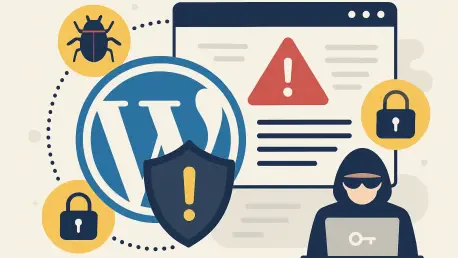Imagine a widely trusted tool, used by over 10,000 website owners to enhance their online presence, suddenly becoming a gateway for cybercriminals to seize control of entire digital platforms. This alarming scenario is unfolding for users of a popular WordPress extension designed to work with the Elementor page builder. Known for adding an array of widgets and templates, this plugin has recently been found to harbor critical security flaws that could jeopardize countless websites. The discovery of these vulnerabilities underscores a persistent challenge within the WordPress ecosystem: balancing the benefits of third-party extensions with the inherent risks they introduce. As cybercriminals increasingly target such weaknesses, the urgency for site administrators to act swiftly cannot be overstated. This article delves into the specifics of the issues, their potential impact, and the broader implications for maintaining a secure online environment.
Unpacking the Security Threats
Critical Vulnerabilities Exposed
The spotlight falls on two severe security flaws recently identified in a widely used WordPress plugin that augments the Elementor page builder with advanced design features. The first issue, tagged as CVE-2025-6327, is an unauthenticated arbitrary file upload vulnerability with a maximum severity score of 10 out of 10. This flaw allows attackers to upload malicious files to a website without any form of authentication, paving the way for potential site takeovers or data breaches. Such a critical vulnerability means that even a moderately skilled threat actor could exploit it under common configurations. The ease of exploitation amplifies the danger, as no special access or permissions are required. Security experts have flagged this as an immediate concern, noting that the ability to inject harmful content into a site could lead to catastrophic consequences, including the loss of sensitive user information or complete control over the platform. Site administrators must recognize the gravity of this threat and prioritize protective measures to safeguard their digital assets.
A second vulnerability, identified as CVE-2025-6325, involves a privilege escalation flaw through a registration endpoint, carrying a near-critical severity score of 9.8 out of 10. This issue permits unauthorized individuals to gain elevated access privileges, effectively bypassing security protocols meant to restrict such actions. Once exploited, attackers could manipulate site settings, access restricted areas, or even install additional malicious software. Unlike more complex exploits that require specific conditions, this flaw is alarmingly straightforward to abuse, further heightening the risk to affected websites. The combination of these two vulnerabilities creates a perfect storm for potential cyberattacks, as they collectively enable both infiltration and control. The cybersecurity community has emphasized that immediate remediation is essential to prevent widespread damage. Updates have been released to address these issues, and ignoring them could leave websites exposed to relentless threats from determined adversaries.
Immediate Actions for Mitigation
Responding to these critical vulnerabilities requires swift and decisive action from WordPress site administrators. The plugin’s developers have released an updated version, 51.1.37, which incorporates robust fixes such as stricter role allowlists, enhanced input sanitization, and improved file upload validation. Applying this update is the most effective way to neutralize the identified threats and prevent unauthorized access or file uploads. Beyond simply installing the patch, it’s vital to verify that no malicious files or unauthorized accounts have already been introduced through these flaws. Conducting a thorough security audit can help detect any signs of compromise that might have occurred prior to the update. Delaying these steps could result in severe repercussions, as cybercriminals are quick to exploit known vulnerabilities in popular plugins. Proactive measures now can avert the need for costly recovery efforts later.
Additionally, site administrators should consider implementing supplementary security practices to bolster their defenses. This includes disabling unnecessary plugins to reduce the attack surface and regularly monitoring site activity for unusual behavior. Employing a web application firewall can provide an extra layer of protection by filtering out malicious traffic before it reaches the site. Furthermore, ensuring that all software components, including themes and the WordPress core, are kept up to date is a fundamental step in maintaining a secure environment. Educating team members about the risks associated with third-party extensions and the importance of timely updates can also prevent future lapses. These combined efforts create a more resilient framework against potential exploits. The urgency of addressing the current flaws cannot be overstated, but establishing a culture of ongoing vigilance will serve as a long-term safeguard against similar issues that may arise in the evolving landscape of cyber threats.
Broader Implications for WordPress Security
The Persistent Challenge of Plugin Risks
The discovery of critical flaws in a popular WordPress extension serves as a stark reminder of the inherent risks associated with third-party plugins. While these tools offer valuable functionality, such as an extensive library of widgets and templates for streamlined website design, they often become prime targets for attackers seeking entry points into WordPress sites. Cybersecurity experts consistently highlight that extensions are among the most exploited components within this ecosystem, as they can introduce vulnerabilities if not rigorously maintained. Reducing the number of installed plugins to only those that are essential is a widely recommended practice to minimize exposure. This incident underscores the need for developers to prioritize security in their coding practices and for users to exercise caution when selecting and managing additional software. The balance between functionality and safety remains a delicate one that demands constant attention.
Beyond individual plugin issues, the broader trend of vulnerabilities in the WordPress environment reveals a systemic challenge that affects millions of websites worldwide. The open-source nature of the platform, while fostering innovation and accessibility, also means that attackers have ample opportunity to study and exploit weaknesses in widely used components. Regular updates and patches are crucial, yet many site owners fail to apply them promptly, leaving their platforms susceptible to known threats. Security advisories frequently stress the importance of staying current with software versions to close off potential attack vectors. This case exemplifies how even popular and feature-rich tools can harbor significant risks if not properly secured. As the digital landscape continues to evolve, fostering a community-wide commitment to robust security practices will be essential in protecting the integrity of countless online platforms against persistent and sophisticated threats.
Strengthening Defenses for the Future
Looking ahead, the WordPress community must adopt a more proactive stance to address the recurring issue of plugin vulnerabilities. Developers are encouraged to integrate stringent security measures during the creation of extensions, including thorough testing and adherence to best practices in coding. Meanwhile, site administrators should establish routine checks to ensure that all components of their websites are updated and free from known issues. Leveraging automated tools for vulnerability scanning can help identify potential weaknesses before they are exploited. Collaboration between developers, security researchers, and users is also vital to quickly address emerging threats. By sharing knowledge and resources, the community can build a stronger defense against the tactics employed by cybercriminals. The lessons learned from recent plugin flaws must inform future strategies to create a safer digital environment.
Reflecting on past responses to similar security incidents, it’s evident that timely action made a significant difference in mitigating widespread damage. The release of patched versions often curbed the potential for large-scale exploitation, as seen in various cases where swift updates protected numerous websites. Encouraging a mindset of preparedness, administrators were advised to back up their sites regularly, ensuring a recovery option in the event of a breach. Going forward, investing in comprehensive security solutions and staying informed about emerging threats will be key steps in safeguarding WordPress platforms. Exploring partnerships with cybersecurity firms for enhanced protection or adopting advanced monitoring systems could provide additional layers of defense. As threats evolve, so must the strategies to counter them, ensuring that the vibrant community of WordPress users remains resilient against the challenges posed by an ever-changing landscape of digital risks.









